Related Research Articles

Augustinians are members of Christian religious orders that follow the Rule of Saint Augustine, written in about 400 AD by Augustine of Hippo. There are two distinct types of Augustinians in Catholic religious orders dating back to the 12th–13th centuries:
Agostino Steuco (1497/1498–1548), Italian humanist, Old Testament scholar, Counter Reformation polemicist and antiquarian, was born at Gubbio in Umbria. He discoursed on the subject of perennial philosophy and coined the term philosophia perennis.

San Pietro in Ciel d'Oro is a Catholic basilica of the Augustinians in Pavia, Italy, in the Lombardy region. Its name refers to the mosaics of gold leaf behind glass tesserae that decorates the ceiling of the apse. The plain exterior is of brick, with sandstone quoins and window framing. The paving of the church floor is now lower than the modern street level of Piazza San Pietro in Ciel d'Oro, which lies before its façade.

Saint Martin of Leon was a priest and canon regular of the Augustinian Order. Born at León, Martin, along with his father Juan, withdrew from the world to the canonry of St. Marcellinus in León after the death of his mother. Martin was educated at this canonry, and after the death of his father, Martin decided to undertake a major pilgrimage, visiting the cities of Rome and Constantinople.
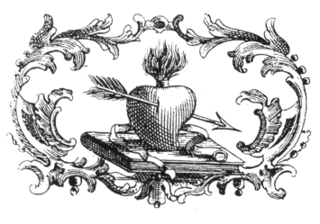
The Order of Saint Augustine, abbreviated OSA, is a religious mendicant order of the Catholic Church. It was founded in 1244 by bringing together several eremitical groups in the Tuscany region who were following the Rule of Saint Augustine, written by Saint Augustine of Hippo in the fifth century.
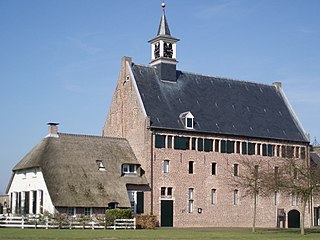
The Congregation of Windesheim is a congregation of Augustinian canons regular. It takes its name from its most important monastery, which was located at Windesheim, about four miles south of Zwolle on the IJssel, in the Netherlands.
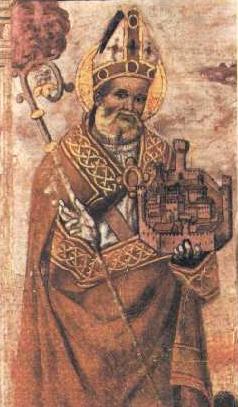
Ubald of Gubbio was a medieval bishop of Gubbio, in Umbria, today venerated as a saint by the Catholic Church. Saint Ubaldo Day is still celebrated at the Basilica of Sant'Ubaldo in Gubbio in his honor, as well as at Jessup, Pennsylvania.

The Basilica of Saint Nicholas of Tolentino is a Roman Catholic church and minor basilica that is part of the Augustinian monastery in the hill-town of Tolentino, province of Macerata, Marche, central Italy. The church is a former cathedral of the Roman Catholic Diocese of Tolentino, suppressed in 1586.
Teresio Maria Languasco (1651–1698) was an Italian painter and an Augustinian friar.

The Biblioteca Angelica is a public library located in Rome, Italy. In front of the Piazza Sant'Agostino square, adjacent to the church of Sant'Agostino, not far from Piazza Navona.

Eleutherius (or Eleut erus or Eleftherios; sometimes called Liberalis or Liberator, the former transliterations and the latter translations of his and his mother Antia are venerated as Christian saints and martyrs in Greece and Albania.

San Giorgio in Braida is a Roman Catholic church in Verona, region of Veneto, Italy. A church titled San Giacomo in Braida, was located in Cremona, and became superseded by Sant'Agostino.

Christianity and religion in general has always been an important part of the social and cultural life of Naples. It is the seat of the Archdiocese of Naples, and the Catholic faith is highly important to the people of Naples and there are hundreds of historic churches in the city. The Cathedral of Naples is the most important place of worship in the city, each year on September 19 it hosts the Miracle of Saint Januarius, the city's patron saint. In the miracle which thousands of Neapolitans flock to witness, the dried blood of Januarius is said to turn to liquid when brought close to relics said to be of his body: this is one of the most important traditions for Neapolitans.

The Abbey of Santa Giustina is a 10th-century Benedictine abbey complex located in front of the Prato della Valle in central Padua, region of Veneto, Italy. Adjacent to the former monastery is the basilica church of Santa Giustina, initially built in the 6th century, but whose present form derives from a 17th-century reconstruction.

The church of Sant'Afra in Brescia, also known as the church of Sant'Afra in Sant'Eufemia, is located on Corso Magenta, near Piazzale Arnaldo.

San Trifone in Posterula was an ancient titular church of Rome, now lost. It was located at the corner of Via dei Portoghesi and Via della Scrofa, in the Campo Marzio rione of the city.
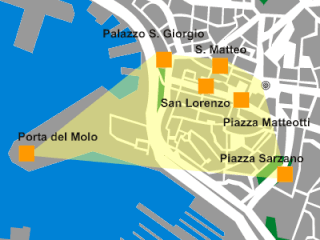
Molo is a neighbourhood in the old town of the Italian city of Genoa. It was one of the six sestieri of ancient Genoa. At present is part of the Genoa's city Municipio I.
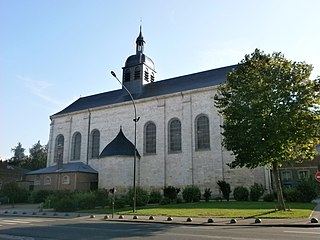
The Abbey of Saint-Acheul was a monastery of Canons Regular in the Saint-Acheul district of Amiens, France. It was founded in the 11th century on the site of an ancient church, and was suppressed in 1790 during the French Revolution. The buildings, which date to the 18th century, were taken over by a college that was entrusted to the Jesuits in 1814. They are now occupied by the private Lycée Saint-Riquier. The abbey church is used as a parish church.

The Monastero or Eremo di Sant'Ambrogio is a 14th-century Roman Catholic church and monastery located on Via Guido Bonarelli #5 nestled on high slopes of Monte Foce, north of Gubbio, region of Umbria, in Italy. It was initially founded as a rustic Franciscan hermitage following Augustinian rules, outside the city walls of Gubbio.

San Pietro is an ancient Roman Catholic church and former monastery located on piazza San Pietro in central Gubbio, region of Umbria, in Italy. The church which displays architectural elements from many centuries, from Romanesque to the Renaissance, as well as housing prominent artworks; the monastery now houses the civic Biblioteca Comunale Sperelliana.
References
- ↑ Fondo Ambiente, entry on monastery.
- ↑ Abbey-Parish of San Secondo.
- ↑ Biblioteca Agostino Steuco, official website.
- ↑ Biblioteca Agostino Steuco